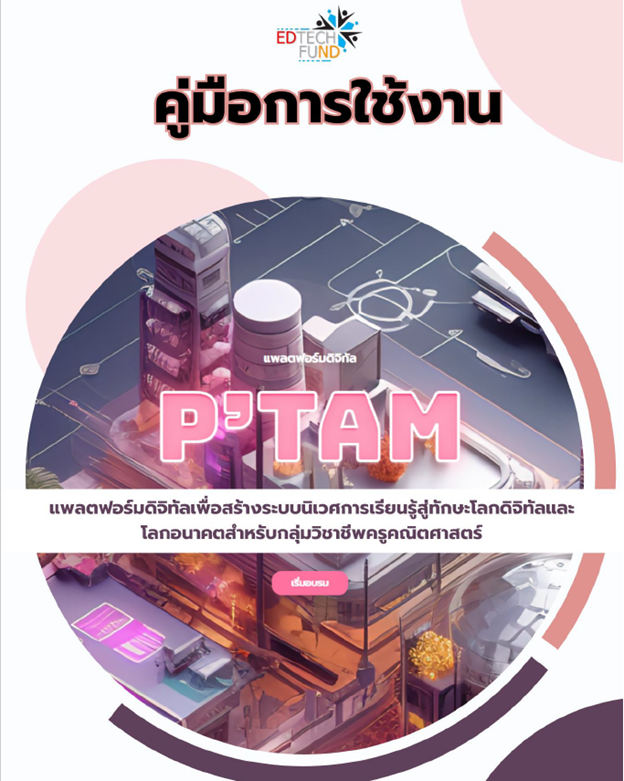Digital Platforms for Mathematics Teachers: A Learning Ecosystem for the Future Digital World
DOI:
https://doi.org/10.14456/educu.2024.36Keywords:
Digital Platform, Learning Ecosystem, Mathematics’ teachersAbstract
The digital platform aims to create a learning ecosystem that develops skills for the digital world and the future, specifically tailored for mathematics ‘teachers, aims to 1) create and develop a digital platform to build a digital and future-ready educational environment for mathematics teachers 2) study the acceptance and confidence in the digital platform for developing digital and future-ready skills among mathematics teachers and 3) disseminate, transfer, and apply technology to create opportunities, equality, and educational coverage across all areas. The target group consists of mathematics teachers in the educational innovation zone of Narathiwat Province, totalling 94 people. Research participants were selected on a voluntary basis. The research tools used include the digital environmental education platform, named P'TAM, a digital learning outcome assessment, and acceptance and confidence surveys. Data analysis was conducted using basic statistics, including percentages, average numerical values, and standard deviations. The research results found that: 1) Digital platform quality assessment: Experts evaluated the digital platform, achieving a high level of quality. The results of online learning by mathematics professionals reached 91.01%, exceeding the 70% benchmark. 2) Acceptance and confidence in the Learning Platform: The study found high levels of acceptance and confidence in the learning platform, with a mean score of 4.30 and a standard deviation of 0.7. And implementing digital technology integration in E-learning to foster a digital learning ecosystem and global digital skills. This initiative aims to create opportunities for equal access and inclusive education, covering all areas by integrating digital technology into teaching and learning through a digital platform.
References
ภาษาไทย
ขวัญชัย ขัวนา และ ธารทิพย์ ขัวนา. (2563). การพัฒนาบทเรียนออนไลน์ (E - LEARNING) รายวิชาการจัดการเรียนรู้สำหรับนักศึกษาหลักสูตรครุศาสตรบัณฑิต ชั้นปีที่ 3 คณะครุศาสตร์ มหาวิทยาลัยราชภัฏกำแพงเพชร. วารสารมหาจุฬานาครทรรศน์, 7(12), 295-306.
ยศวดี ดำทรัพย์, ณรงค์ พุทธิชีวิน, และ วันชัย ธรรมสัจการ. (2562). การพัฒนารูปแบบภาวะผู้นำของผู้บริหารสถานศึกษาในบริบทสังคมพหุวัฒนธรรม. วารสารครุศาสตร์จุฬาลงกรณ์มหาวิทยาลัย, 47(เพิ่มเติม 1), 272-293.
วิเชียร เกตุสิงห์. (2538). ค่าเฉลี่ยกับการแบ่งความหมาย: เรื่องง่าย ๆ ที่บางครั้งก็พลาดได้. ข่าวสารการวิจัยการศึกษา.
วิไลวรรณ วงศ์จินดา, สุวิมล พิบูลย์, และ อนันท์ คัมภิรานนท์. (2564). แพลตฟอร์มการเรียนรู้เพื่อ การพัฒนาทักษะการเรียนในศตวรรษที่ 21 กลุ่มสาขาวิชาทางการศึกษา. [วิทยานิพนธ์ปริญญามหาบัณฑิต ไม่ได้ตีพิมพ์]. มหาวิทยาลัยเทคโนโลยีราชมงคลสุวรรณภูมิ.
ศศิพร เหมือนศรีชัย. (2555). ปัจจัยที่มีผลต่อการยอมรับ ERP Software ของผู้ใช้งานด้านบัญชี. [วิทยานิพนธ์ปริญญามหาบัณฑิต, มหาวิทยาลัยธรรมศาสตร์] TU Digital Collections. https://digital.library.tu.ac.th/tu_dc/frontend/Info/item/dc:121437
สมรักษ์ นันตา. (2564). การพัฒนาบทเรียนออนไลน์ เรื่องการใช้โปรแกรม Scratch วิชา การเขียนโปรแกรมเบื้องต้นสำหรับนักเรียนชั้นมัธยมศึกษาปีที่ 2 โรงเรียนนครไตรตรึงษ์. มหาวิทยาลัยราชภัฎกำแพงเพชร. การประชุมวิชาการระดับชาติ สำหรับนักศึกษามหาวิทยาลัยราชภัฏกำแพงเพชร ครั้งที่ 1, 90-99. https://research.kpru.ac.th/research2/pages/filere/21452021-03-04.pdf.
สำนักงานเลขาธิการสภาการศึกษา. (2563). สภาวะการศึกษาไทย 2561-2562 การปฏิรูปการศึกษาในยุคดิจิทัล. สำนักงานเลขาธิการสภาการศึกษา.
ภาษาอังกฤษ
Alwin, O. (1970). College effects on educational and occupational attainments. American Sociological Review, 39(2), 210-223.
Christensen, C. M. (2012). The innovator's prescription: A disruptive solution for health care. McGraw-Hill Education.
Davis, F. D. (1989). Perceived usefulness, perceived ease of use, and user acceptance of information technology. MIS Quarterly, 13(3), 319–340. https://doi.org/10.2307/249008
Göksün, D. O., & Kurt, A. A. (2017). The relationship between pre-service teachers' use of 21st-Century learner skills and 21st-Century teacher skills. Education and Science, 42(190), 107-130. https://doi.org/10.15390/eb.2017.7089.
García-Holgado, A., & García-Peñalvo, F. J. (2017). Preliminary validation of the metamodel for developing learning ecosystems. In J. M. Dodero, M. S. Ibarra Sáiz, & I. Ruiz Rube (Eds.), Fifth International Conference on Technological Ecosystems for Enhancing Multiculturality (TEEM’17) (Cádiz, Spain, October 18-20, 2017) (Article 91). New York, NY, USA: ACM
Jewyam, J., Songbundit, A., & Srisopha, Y. (2022). The Development of a Multilevel Structural Equation Modeling of Buddhist Ethics of School Adminnistrators affecting the Psychological and Behavior of Teacher in the Buddhist Oriented School under the Office of Basic Education Commistion. Journal of MCU Buddhapanya Review, 7(2), 167-181.
Kondratova, I., Molyneaux, H., & Fournier, H. (2017). “Design considerations for competency functionality within a learning ecosystem.” Learning and collaboration technologies: Novel learning ecosystems. Cham: Springer International Publishing.
Mungprasert, K., Prawatrungruang, S., & Sriprasertpap, K. (2022). Teachers Competency Model in the Era of Thailand 4.0, Phetchaburi Secondary Education Service Area Office. Journal of MCU Buddhapanya Review, 7(1), 78-88.
Pimentel, J. L. (2010). A note on the usage of Likert Scaling for research data analysis. USM R & D, 18(2), 109-112.
Seels, B. B., & Richey, R. C. (1994). Instructional technology: The definition and domains of the field. Association for Educational Communications and Technology.
Veeramanickam, M. R. M., & Ramesh, P. (2022). Analysis on quality of learning in e-Learning platforms. Advances in Engineering Software, 172, 103168.ttps://doi.org/10.1016/j.advengsoft.2022.103168.

Downloads
Published
How to Cite
Issue
Section
License

This work is licensed under a Creative Commons Attribution-NonCommercial-NoDerivatives 4.0 International License.



